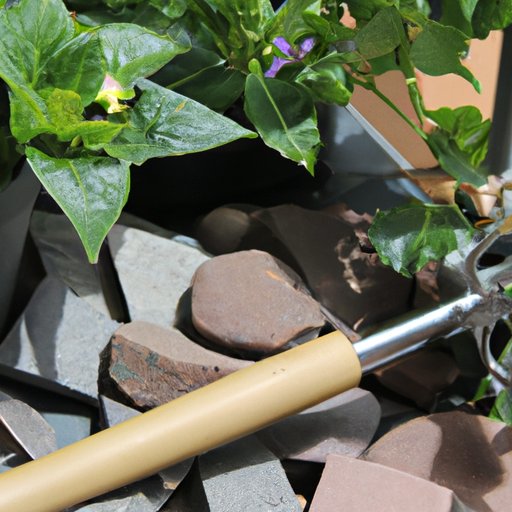
Introduction
Hydrangeas are beautiful, showy and versatile plants that can liven up any garden. As a gardener, you’ll find joy in taking care of hydrangeas and in return, they will reward you with stunning blooms that can last from spring to fall. In this article, we’ll go over the basics of hydrangea care, common problems to look out for, how to maximize their growth, and practical ideas on how to style hydrangeas.
Start with the Basics
Before you start caring for hydrangeas, it’s essential to understand what hydrangeas are and the different types available.
Hydrangeas are deciduous shrubs that come in different sizes, shapes, and colors. Most hydrangeas grow between 3-6 feet tall and wide. Hydrangeas are known for their large, showy blooms that come in a variety of colors such as pink, blue, purple, and white, among others. The most common hydrangea varieties are the Big Leaf hydrangea, Panicle hydrangea, Smooth hydrangea, and Climbing hydrangea.
Hydrangeas grow well in zones 3-9 and are best planted in early autumn or spring. It’s important to choose an ideal planting location for your hydrangeas, considering the type of hydrangea you have and its soil, lighting, and watering needs.
For all hydrangea types, the soil should be loose, well-draining, and rich in organic matter. Hydrangeas prefer partial shade and may require a few hours of morning sun to thrive. Excessive exposure to sunlight can lead to leaf and bloom damage. Regular watering is necessary, especially during dry weather, to keep the soil moist but not waterlogged.
Before planting hydrangeas, ensure you have the necessary tools such as a hand trowel, garden gloves, fertilizers, and mulch.
Highlight Common Problems Faced by Hydrangea Owners
Hydrangeas are not immune to several problems that could damage or inhibit their growth. Most problems arise due to environmental factors, pests, and diseases.
Leaf spot, powdery mildew and bud blight are some of the most common fungal diseases that affect hydrangeas. These diseases can result in leaf death, reduced blooms, and even plant death. To prevent fungal diseases, avoid watering from overhead late in the day, as it can create the ideal condition for fungi to grow. Ensure that air circulates around your hydrangeas and remove any infected foliage. If your hydrangea has signs of an advanced fungal infection, consider using a fungicide or contacting a professional.
Hydrangeas can also be a target for insects such as aphids, spider mites, and Japanese beetles. These pests cause harm by sucking the sap from the leaves, flowers, and stems of the hydrangea. If you notice holes, deformities, or discolored foliage, your hydrangea may be under attack from pests. Applying horticultural soap or oil can be helpful, but if the problem persists, consider consulting a professional.
If your hydrangea fails to bloom, it could be due to incorrect pruning practices, overly shaded locations, or insufficient nutrients. If you’re inappropriately pruning your hydrangeas, particularly the Big Leaf hydrangea, it could lead to significant damage that will lead to the plant not blooming. Ensuring that your hydrangea is planted on soil rich in nutrients and gets adequate sunlight can also promote stronger blooms.
Offer Advice on How to Maximize Hydrangea Growth
Pruning is an essential practice when taking care of hydrangeas. Pruning helps to control the size of the plant, encourage healthy growth, and promote blooming. Pruning should be done regularly, and the timing depends on the type of hydrangea as well as the growing zone.
The Big leaf hydrangea and Oakleaf hydrangea bloom on old wood, which means they produce buds in the fall that will produce flowers the following year. These plants should be pruned immediately after flowering. Similarly, the Panicle hydrangea and Smooth hydrangea bloom on new wood, which means they produce buds on the current season’s growth. These plants should be pruned in late winter or early spring.
Maximizing hydrangea growth entails creating the ideal environment for them to thrive. Providing adequate water, fertilizer, and soil conditions can promote healthy growth. Applying fertilizers rich in potash and phosphorus is particularly helpful for promoting blooming. Avoid applying fertilizers too often, as it can lead to less growth.
Showcase Creative Ways to Style Hydrangeas
Hydrangeas are not just wonderful in the garden, but their blooms are perfect for styling and decorating both indoors and outdoors. Here are some ideas:
Indoor styling:
- Cut Hydrangeas in a tall vase or pot to add a pop of color to your room.
- Dry your blooms upside down and create an autumn wreath.
- Create a dried flower bouquet for display in your home.
Outdoor styling:
- Plant Hydrangeas along fences or walls to create a colorful hedge.
- Create a focal point by planting a single hydrangea or a small grouping in a decorative container.
- Plant hydrangeas in rows to create gorgeous borders around your yard or driveway.
When cutting hydrangeas, it’s essential to do so at the right time to ensure the blooms last long. Cutting the blooms when they’re just turning colors will ensure they last for several weeks.
Wrap Up with a Summary of Things to Remember
Hydrangeas are easy to grow and stunning in any garden. Following the guidelines mentioned in this article can help you take care of your hydrangeas and enjoy their blooms throughout the year. Remember to provide an ideal environment for your hydrangeas, identify and deal with potential problems, and prune your plants appropriately. If you’re unsure about how best to take care of your hydrangeas, consult a professional or refer to helpful resources.
Conclusion
Hydrangeas are beautiful and exciting to grow, and with appropriate care, you can enjoy these stunning plants for years to come. We hope this article has been informative and helpful in assisting you in taking care of your hydrangeas. Remember to provide an ideal environment, style your blooms, and enjoy the beauty of hydrangeas.




